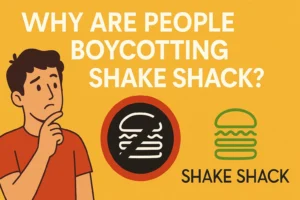
Shake Shack is a popular fast-casual restaurant chain known for its delicious burgers, crinkle-cut fries, and shakes. But if you’re following a gluten-free diet due to celiac disease, gluten sensitivity, or personal preference, you might wonder: Are Shake Shack fries gluten-free?
Are Shake Shack Fries Gluten-Free?
Yes, Shake Shack’s standard crinkle-cut fries are gluten-free. They are made from potatoes, sunflower oil, and salt, with no gluten-containing ingredients. Additionally, they are cooked in a dedicated fryer, reducing the risk of cross-contamination with gluten items like chicken or breaded foods.
However, Shake Shack states that their kitchens are not 100% gluten-free environments, meaning there’s still a slight chance of cross-contact. If you have celiac disease or severe gluten intolerance, you should exercise caution.
Shake Shack Fries Menu: Ingredients & Allergen Info
Below is a detailed table of Shake Shack’s fries options, including ingredients and gluten-free status:
| Fries Item | Ingredients | Gluten-Free? | Allergen Notes |
|---|---|---|---|
| Crinkle-Cut Fries | Potatoes, sunflower oil, salt | ✅ Yes (no gluten ingredients) | Cooked in a dedicated fryer, but cross-contact possible |
| Cheese Fries | Crinkle-cut fries, cheese sauce | ❌ No (cheese sauce contains wheat) | Contains gluten due to cheese sauce |
| Bacon Cheese Fries | Crinkle-cut fries, cheese sauce, bacon | ❌ No (cheese sauce contains wheat) | Contains gluten |
People searching for : Are Shake Shack Fries Vegan?
Key Takeaways:
- Plain fries = gluten-free (but risk of cross-contact)
- Cheese fries & bacon cheese fries = NOT gluten-free (due to wheat in cheese sauce)
Cross-Contamination Risks at Shake Shack
While Shake Shack’s fries are made without gluten ingredients, cross-contamination can occur in the kitchen. Here’s why:
- Shared cooking spaces – Though fries have a dedicated fryer, other gluten-containing foods (like chicken tenders or buns) are prepared nearby.
- Handling procedures – Employees may handle gluten-containing items before touching fries.
Should You Eat Shake Shack Fries If You Have Celiac Disease?
- Low to moderate risk – The dedicated fryer minimizes risk, but it’s not 100% safe for those with severe gluten allergies.
- Ask staff – Request that they change gloves and avoid shared utensils when preparing your order.
People wanna know : What Cheese Does Shake Shack Use?
Gluten-Free Alternatives at Shake Shack
If you’re avoiding gluten, here are some safe options at Shake Shack:
✅ Gluten-Free Menu Items
- Burger (no bun or gluten-free bun) – Shake Shack offers a gluten-free bun (Udi’s brand) upon request.
- Hot Dogs (no bun) – The ShackMeister Dog is gluten-free without the bun.
- Frozen Custard (vanilla/chocolate) – Most flavors are gluten-free, but avoid mix-ins like cookies or brownies.
- Beverages – All sodas, lemonade, and iced tea are gluten-free.
❌ Items to Avoid (Contain Gluten)
- Burgers with regular buns
- Chicken sandwiches & tenders (breaded with wheat)
- Shakes with cookie/candy mix-ins (Oreo, etc.)
- Certain sauces (e.g., Shack Sauce, cheese sauce—both contain wheat)
FAQs
No, they use a dedicated fryer for fries, so they don’t share oil with gluten-containing foods like chicken tenders.
Yes! They offer a gluten-free bun (Udi’s brand) for burgers upon request.
No, the cheese sauce contains wheat, making them unsafe for gluten-free diets.
While the fries themselves are gluten-free, cross-contact is possible. Those with severe gluten allergies should proceed with caution.
Most basic shakes (vanilla, chocolate, strawberry) are gluten-free, but avoid mix-ins like cookies or brownies.
Shake Shack’s plain crinkle-cut fries are gluten-free (no gluten ingredients, cooked in a dedicated fryer), but cross-contamination is possible. Avoid cheese fries (contain wheat). Not celiac-safe. (30 words)
Shake Shack fries its famous crinkle-cut fries in 100% sunflower oil, which is naturally gluten-free and free of trans fats. The fries are cooked in a dedicated fryer (not shared with gluten-containing items like chicken), reducing cross-contamination risk.
Key Details:
- Oil: Sunflower oil (non-GMO, no additives)
- Dedicated Fryer: Fries only (no shared oil with breaded items)
- Allergen Note: No gluten ingredients, but kitchen isn’t 100% gluten-free
Great choice for gluten-free diets, but those with celiac disease should still exercise caution due to potential cross-contact.
Can You Eat Shake Shack Fries Gluten-Free?
✅ Yes, Shake Shack’s plain crinkle-cut fries are gluten-free in ingredients and preparation.
⚠️ But cross-contamination is possible, so those with celiac disease should assess their own risk tolerance.
❌ Avoid cheese fries & bacon cheese fries, as they contain gluten.
If you’re gluten-free, you can still enjoy a burger on a gluten-free bun or a hot dog without a bun alongside the fries. Always inform staff of dietary restrictions to minimize cross-contact risks.
Read more : Does Shake Shack Have Gluten Free Buns?






